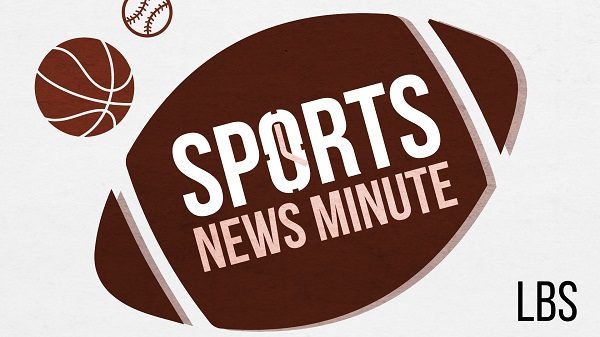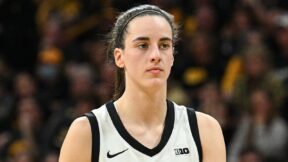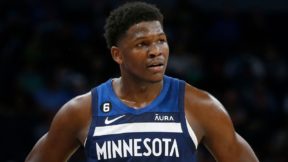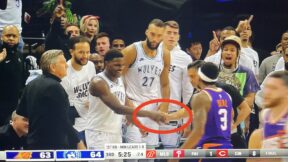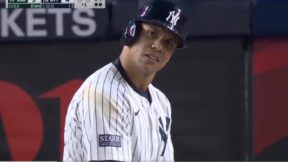Why Kaleb McGary looks like a great pick for the Atlanta Falcons

The Atlanta Falcons invested heavily in their offensive line in the 2019 NFL draft. They selected Chris Lindstrom at 14th overall, then traded back into the end of the first round with the Los Angeles Rams to take Kaleb McGary, the offensive tackle out of Washington.
In looking at these two picks, it’s pretty clear that they were the result of both scouting and analytics working together to identify quality offensive linemen worthy of selection as starters. The Atlanta Falcons are one of the franchises at the leading edge of analytics in the NFL, as they have both a Vice President of Technology, Data, and Analytics (Karl Pierburg) and a Football Analytics Coordinator (John Taormina). And the fingerprints of an objective look at what matters in offensive linemen is there, if you know where to look.
Kaleb McGary put up a 33.5 inch vertical jump, which was the second-highest for any drafted offensive tackle (behind Joshua Miles, a seventh-round pick of the Cardinals). He was better than average for a typical early round tackle in all other Combine categories except one: bench press. Meanwhile, Chris Lindstrom put up the second-longest broad jump among offensive lineman, behind only Andre Dillard, and was also well above average athletically in all the other categories except, you guessed it, the bench press. It’s not that these two wouldn’t put mere mortals to shame in lifting 225 pounds well over 20 times each, but compared to other top line prospects, it is the one area where they did not stand out.
So let’s take a look at all offensive tackle prospects who were drafted in the first or second rounds from 2000 to 2014. Using data found at Pro Football Reference on Combine results, and filling in data from pro days where it could be found, I put together a list of athletic testing results for top linemen. Not every top prospect is included, but most from the last generation of football players are.
Here are the correlation coefficients between various athletic testing results and the approximate value (as listed and calculated at Pro Football Reference) for the first five years of each tackle’s career. For a refresher on correlation, a number near zero represents that there is basically no relationship between the two items, while a number near 1 would mean a strong, positive relationship. A number approaching -1 would mean a strong inverse relationship. For example, we would expect that there would be an inverse relationship between draft slot (where lower is better) and career games started.
40-TIME = -0.36
SHUTTLE = -0.33
BROAD JUMP = +0.30
3-CONE = -0.28
VERTICAL JUMP = +0.27
HAND SIZE = -0.16
WEIGHT -0.09
ARM LENGTH = +0.03
BENCH PRESS = +0.03
HEIGHT = -0.01
Most of the athletic testing does matter to some extent when it comes to linemen and predicting who will succeed, showing what I would call modest correlations. The one that has had no relationship may be counter-intuitive: bench press. Sure, these guys are strong compared to the population at large, but being significantly stronger than your fellow top line prospects does not seem to translate to more career success. Arm length, another obsession, also shows no relationship even though you will hear it over and over during draft season.
For a comparison, the correlation between draft position and first-five-year approximate value for this same group was -0.31. That’s in the same range as these other athletic testing categories (besides bench press), and you would have had just as much success predicting who would succeed or not based on looking at testing numbers as you would have just by going on draft position. Probably more if you combined both approaches.
Here are the offensive tackles taken in the first 20 picks of a draft who put up below average test numbers in at least three of the five important categories.
Jason Smith
Greg Robinson
Eugene Monroe
Jake Long
Gosder Cherilus
Chris Williams
Branden Albert
Leonard Davis
Jeff Backus
Levi Brown
Andre Smith
If you had red-flagged a lot of these players, you would have been better off as a franchise. Jake Long is the only one who was selected to a Pro Bowl during his initial five years in the league. Several qualify as outright busts, and others required position changes to fulfill their potential.
Meanwhile, here are the opposite: Players drafted outside the top 20 who tested well in at least three of the five categories and at least one of the jumping categories.
Joe Staley
Daryn College
Anthony Castonzo
Rodger Saffold
Khalif Barnes
Duane Brown
Will Beatty
Jon Stinchcomb
Chad Clifton
Andrew Whitworth
That group outperforms their earlier-drafted peers with questionable Combine testing results, with five Pro Bowlers to three, and no outright busts.
Kaleb McGary (as well as Andre Dillard, whom another analytically-inclined franchise in the Philadelphia Eagles traded up to get) would be part of that group, and was above average in every category but bench press compared to early drafted tackles from 2000-2014. Jonah Williams, meanwhile, who went No. 11 overall and was the first offensive lineman taken, was below average in four of the five categories, only being slightly above average in 40-yard dash time.
If we look at vertical jump performance, the category where McGary excelled the most compared to most linemen, here is how careers turned out among those drafted in 2000-2014, based on being assigned to six categories: DNP (Did not participate), POOR, BELOW AVERAGE, AVERAGE, ABOVE AVERAGE, and EXCELLENT.
Games Started in First Five Years/Pro Bowl Seasons/Approximate Value:
DNP = 48.8 / 0.1 / 26
POOR = 45.6 / 0.0 / 22
BELOW AVG = 57.0 / 0.4 / 29
AVERAGE = 61.8 / 0.4 / 31
ABOVE AVG = 60.9 / 0.9 / 35
EXCELLENT = 60.0 / 0.7 / 32
None of the worst leapers made a pro bowl. Jeff Otah had the worst vertical of any player taken in the first round over that period and Jason Smith, a notorious bust as a second overall pick, was also among them. It also looks like teams are rightly cautious to view linemen who don’t test in a category with skepticism and not take risks there (We just saw Jawaan Taylor drop to the second round over medical concerns, and he did not do most tests at the Combine).
The above-average and excellent vertical jumpers were about twice as likely make a Pro Bowl as their peers who were closer to average. Lane Johnson, Russell Okung, Joe Staley, Jon Stinchcomb, Joe Thomas, and Trent Williams are all guys who posted a vertical above 32 inches and went on to make a Pro Bowl.
When you look at the Combine profiles of McGary coupled with Lindstrom, I don’t think it is any accident that these are players who the franchise targeted (I suspect they would have also been fine with Andre Dillard). Lindstrom just put up one of the best broad jumps of any guard prospect, and his athletic profile looks like that of an elite tackle prospect if you did not know that he was a guard. Atlanta targeted these players, and they fit the profile of guys who have worked out in the past.

